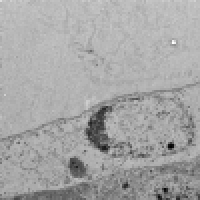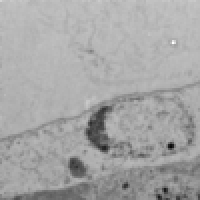Gaussian downsampling of an image with ImageJ on-board tools.
Motivation
Sound downsampling of an image requires the elimination of image frequencies higher than half the sampling frequency in the result image (see the Nyquist–Shannon sampling theorem). The exclusive tool for this is Gaussian convolution.
Download
Get a snapshot from the git repository here: downsample_.js.
Documentation
This script calculates the required Gaussian kernel for a given target width or height, smooths the image and resamples it. The target size must be smaller than the source image size.
Furthermore, you can define the “intrinsic” Gaussian kernel of the source and target images. An optimal sampler is identified by sigma=0.5. If your source image was blurred already, you may set a higher source sigma for a sharper result. Setting target sigma to values smaller than 0.5 makes the result appear sharper and therefore eventually aliased.
This script is maintained by Stephan Saalfeld.
Example
A picture is worth a thousand words, so here is an example. You see a 2,048×2,048px transmission electron micrograph downsampled to 100×100px. For better illustration, the examples are shown at 200%.

ImageJ interpolated scaling

Gaussian downsampling with target sigma=0.25

Gaussian downsampling with target sigma=0.5
Code
/**
* Gaussian downsampling of an image with ImageJ on-board tools.
*
* Motivation:
* Sound downsampling of an image requires the elimination of image frequencies
* higher than half the sampling frequency in the result image (see the
* Nyquist-Shannon sampling theorem). The exclusive tool for this is Gaussian
* convolution.
*
* This script calculates the required Gaussian kernel for a given target size,
* smoothes the image and resamples it.
*
* Furthermore, you can define the "intrinsic" Gaussian kernel of the source and
* target images. An optimal sampler is identified by sigma=0.5. If your
* source image was blurred already, you may set a higher source sigma for a
* sharper result. Setting target sigma to values smaller than 0.5 makes the
* result appear sharper and therefore eventually aliased.
*/
var imp = WindowManager.getCurrentImage();
var width = 0;
var height = 0;
var sourceSigma = 0.5;
var targetSigma = 0.5;
var widthField;
var heightField;
var fieldWithFocus;
var textListener = new java.awt.event.TextListener(
{
textValueChanged : function( e )
{
var source = e.getSource();
var newWidth = Math.round( widthField.getText() );
var newHeight = Math.round( heightField.getText() );
if ( source == widthField && fieldWithFocus == widthField && newWidth )
{
newHeight = Math.round( newWidth * imp.getHeight() / imp.getWidth() );
heightField.setText( newHeight );
}
else if ( source == heightField && fieldWithFocus == heightField && newHeight )
{
newWidth = Math.round( newHeight * imp.getWidth() / imp.getHeight() );
widthField.setText( newWidth );
}
}
} );
var focusListener = new java.awt.event.FocusListener(
{
focusGained : function ( e )
{
fieldWithFocus = e.getSource();
},
focusLost : function( e ){}
} );
if ( imp )
{
width = imp.getWidth();
height = imp.getHeight();
gd = new GenericDialog( "Downsample" );
gd.addNumericField( "width :", width, 0 );
gd.addNumericField( "height :", height, 0 );
gd.addNumericField( "source sigma :", sourceSigma, 2 );
gd.addNumericField( "target sigma :", targetSigma, 2 );
gd.addCheckbox( "keep source image", true );
var fields = gd.getNumericFields();
widthField = fields.get( 0 );
heightField = fields.get( 1 );
fieldWithFocus = widthField;
widthField.addFocusListener( focusListener );
widthField.addTextListener( textListener );
heightField.addFocusListener( focusListener );
heightField.addTextListener( textListener );
gd.showDialog();
if ( gd.wasOKed() )
{
width = gd.getNextNumber();
height = gd.getNextNumber();
sourceSigma = gd.getNextNumber();
targetSigma = gd.getNextNumber();
keepSource = gd.getNextBoolean();
if ( width <= imp.getWidth() )
{
var s;
if ( fieldWithFocus == widthField )
s = targetSigma * imp.getWidth() / width;
else
s = targetSigma * imp.getHeight() / height;
if ( keepSource )
IJ.run( "Duplicate...", "title=" + imp.getTitle() + " duplicate" );
IJ.run( "Gaussian Blur...", "sigma=" + Math.sqrt( s * s - sourceSigma * sourceSigma ) + " stack" );
IJ.run( "Scale...", "x=- y=- width=" + width + " height=" + height + " process title=- interpolation=None" );
IJ.run( "Canvas Size...", "width=" + width + " height=" + height + " position=Center" );
}
else
IJ.showMessage( "You try to upsample the image. You need an interpolator for that not a downsampler." );
}
}
else
IJ.showMessage( "You should have at least one image open." );